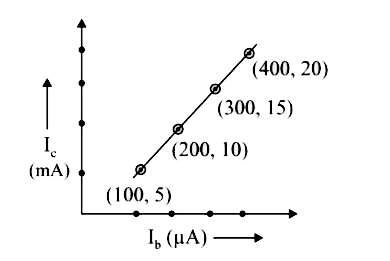When load resistance, in a triode amplifier are 50kΩand100kΩ, the respective values of voltage gain are 25 and 30. Determine the plate resistance.
Av=μRLrp+RL
25=50μrp+50 RL is substituted in kΩ
and30=100μrp+100 2530=rp+1002(rp+50)
or6rp+600=10rp+500or4rp=100orrp25kΩ
Similar Questions
In a common base transistor the value of load resistance in output and input circuit is 500 kω and 300 ω respectively calculate the voltage gain and power gain if value of current gain is 0.90
View SolutionThe gain factor of an amplifier is increased from 10 to 12 as the load resistance is changed from 4kΩ to 8kΩ. Calculate (a) the amplification factor and (b) the plate resistance.
View Solution
Knowledge Check
With a change of load resistance of a triode, used as an amplifier, from 50 k ilo o h m s to 100 k ilo o h m s , its voltage amplification changes from 25 to 30. Plate resistance of the triode is
A25kΩB75kΩC7.5kΩD2.5kΩThe triodes P and Q have the same amplification factor 40. Their plate resistances are 4kΩ and 8kΩ, respectively. If an amplifier circuit is designed using anyone of them and a load resistance is of 8kΩ, the ratio of the voltage gain obtained from them will be
A2:3B4:3C3:1D1:2The transconductance of a triode amplifier is 2.5 mili mho having plate resistance of 20kΩ, amplification 10. Find the load resistance
A5kΩB25kΩC20kΩD50kΩ
The transfer characteristic curve of a transistor, having input and output resistance 100Ωand100kΩ respectively, is shown in the figure. The Voltage and Power gain, are respectively:

View SolutionThe transfer characteristic curve of a transistor, having input and output resistance 100Ωand100kΩ respectively, is shown in the figure. The Voltage and Power gain, are respectively:

View SolutionThe transfer characteristic curve of a transistor, having input and output resistance 100Ωand100kΩ respectively, is shown in the figure. The Voltage and Power gain, are respectively:

View SolutionThe voltage of a triode amplifier with a resistive load of 5kΩ is 10 while with a resistive load of 12kΩ. It is 15. Calculate the amplification factor and plate resistance of the triode.
View SolutionThe dynamic plate resistance of a triode valve is 10kΩ. Find the change in the plate current if the plate voltage is changed from 200V to 220V.
View Solution
